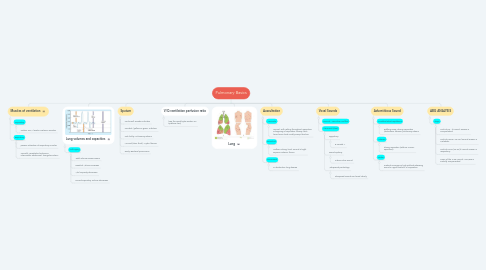
1. Muscles of ventilation
1.1. Inspiratory
1.1.1. scaleni, SCM, levator costarum serratus
1.2. Expiratory
1.2.1. passive relaxation of inspiratory muscles
1.2.2. Forceful: Quadratus lumborum, intercostals, abdominal, triangularis sterni
2. Lung volumes and capacities
2.1. With aging
2.1.1. Tidal volume remains same
2.1.2. Residual Volume increases
2.1.3. Vital Capacity decreases
2.1.4. Forced expiratory volume decreases
3. Sputum
3.1. Foul smell: aerobic infection
3.2. Purulent: (yellow or green- infection
3.3. Pink frothy: Pulmonary edema
3.4. Mucoid (clear, thick) : Cystic fibrosis
3.5. Rusty: Bacterial pneumonia
4. V/Q ventilation perfusion ratio
4.1. (See the quick bytes section on nptehive.com)
5. Lung
6. Auscultation
6.1. Vescicular
6.1.1. normal, soft rustling throughout inspiration & begining of expiration, breezy, faint, heard over chest mostly except trachea
6.2. Bronchial
6.2.1. Hollow, echoig, loud, normal at right superior anterior thorax
6.3. Decreased
6.3.1. in obstructive lung disease
7. Vocal Sounds
7.1. Normal : Less clear, muffled
7.2. Abnormal (clear)
7.2.1. Egophony
7.2.1.1. E sounds A
7.2.2. Bronchophony
7.2.2.1. intense clear sound
7.2.3. Whispered pectorilquy
7.2.3.1. whispered sounds are heard clearly
8. Adventitious Sound
8.1. Crackles/rales/crepitations
8.1.1. Rattling noise, during inspiration (atelectasis, fibrosis, pulmonary edema
8.2. Wheeze
8.2.1. during expiration (asthma, COPD, aspiration)
8.3. strider
8.3.1. medical emergency, high pitched wheezing sound in upper bronchi, in inspiration
9. ABG ANALYSIS
9.1. Steps
9.1.1. Look at pH : If normal, answer is compensated
9.1.2. Look at PaCo2: 35-45 if normal answer is Metabolic
9.1.3. Look at HCo3 (22-26) If normal answer is respiratory'
9.1.4. None of the 3 are normal ANSWER is Partially compensated

